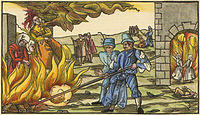
Photo from wikipedia
Novel coronavirus pneumonia has had a significant impact on people's lives and psychological health. We developed a stage model to analyse the spatial and temporal distribution of public panic during… Click to show full abstract
Novel coronavirus pneumonia has had a significant impact on people's lives and psychological health. We developed a stage model to analyse the spatial and temporal distribution of public panic during the two waves of the coronavirus disease 2019 (COVID-19) pandemic. We used tweets with geographic location data from the popular hashtag ‘Lockdown Diary’ recorded from 23 January to April 8, 2020, and ‘Nanjing Outbreak’ recorded from 21 July to 1 September 2021 on Weibo. Combining the lexicon-based sentiment analysis and the grounded theory approach, this panic model could explain people's panic and behavioural responses in different areas at different stages of the pandemic. Next, we used the latent Dirichlet allocation topic model to reconfirm the panic model. The results showed that public sentiments fluctuated strongly in the early stages; in this case, panic and prayers were the dominant sentiments. In terms of spatial distribution, public panic showed hierarchical and neighbourhood diffusion, with highly assertive expressions of sentiment at the outbreak sites, economically developed areas, and areas surrounding the outbreak. Most importantly, we considered that public panic was affected by the 17 specific topics extracted based on the perceived and actual distance of the pandemic, thus stimulating the process of panic from minimal, acute, and mild panic to perceived rationality. Consequently, the public's behavioural responses shifted from delayed, negative, and positive, to rational behavioural responses. This study presents a novel approach to explore public panic from both a time and space perspective and provides some suggestions in response to future pandemics.
Journal Title: International Journal of Disaster Risk Reduction
Year Published: 2022
Link to full text (if available)
Share on Social Media: Sign Up to like & get
recommendations!